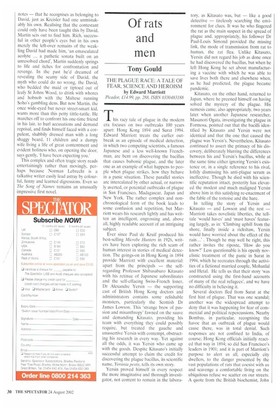Of rats and men
Tony Gould
THE PLAGUE RACE: A TALE OF FEAR, SCIENCE AND HEROISM by Edward Marriott Picador, L14.99. pp. 288, ISBN 0330483188 This racy tale of plague in the modern era focuses on two outbreaks 100 years apart: Hong Kong 1894 and Surat 1994. Edward Marriott treats the earlier outbreak as an episode of medical detection, in which two competing scientists, a famous Japanese and a less well-known Frenchman, are bent on discovering the bacillus that causes bubonic plague, and the later one as an example of what happens to people when plague strikes, how they behave in a panic situation. These parallel stories are intercalated by other actual, or narrowly averted, or potential outbreaks of plague in San Francisco, Madagascar, Japan and New York. The rather complex and nonchronological form of the book leads to some confusion and repetition, but Marriott wears his research lightly and has written an intelligent, engrossing and, above all, highly readable account of an intriguing subject.
Ever since Paul de Kruif produced his best-selling Microbe Hunters in 1926, writers have been exploring the rich seam of human interest in stories of medical detection. The goings-on in Hong Kong in 1894 provide Marriott with excellent material: apart from the principals — the selfregarding Professor Shibasaburo Kitasato with his retinue of Japanese subordinates and the self-effacing Swiss-French loner, Dr Alexandre Yersin — the supporting cast of British Hong Kong doctors and administrators contains some relishable monsters, particularly the Scottish Dr James Lowson. This 'strange brew of passion and misanthropy' fawned on the suave and demanding Kitasato. providing his team with everything they could possibly require, but treated the gauche and unassertive Yersin with contempt, obstructing his research in every way. Yet against all the odds, it was Yersin who came up with the goods. Despite Kitasato's initially successful attempt to claim the credit for discovering the plague bacillus, its scientific name, Yersinia pestis, tells its own story.
Yersin proved himself in every respect the more imaginative and thorough investigator, not content to remain in the labora
tory, as Kitasato was, but — like a good detective — tirelessly searching the environment for clues. It was he who fingered the rat as the main suspect in the spread of plague and, appropriately, his follower Dr Paul-Louis Simond provided the missing link, the mode of transmission from rat to human, the rat flea. Unlike Kitasato, Yersin did not regard his job as done once he had discovered the bacillus, but when he left Hong Kong he set about manufacturing a vaccine with which he was able to save lives both there and elsewhere when, as he had predicted, the plague became pandemic.
Kitasato, on the other hand, returned to Japan, where he preened himself on having solved the mystery of the plague. His nemesis came, also appropriately, two years later when another Japanese researcher, Masanori Ogata, investigating the plague in Formosa, pointed out that the bacilli identified by Kitasato and Yersin were not identical and that the one that caused the plague was Yersin's. Nevertheless, Kitasato continued to assert the primacy of his discovery, deliberately blurring the differences between his and Yersin's bacillus, while at the same time either ignoring Yersin's existence or, in a single reference to his rival, loftily dismissing his anti-plague serum as ineffective. Though he died with his scientific reputation intact, posterity has elevated the modest and much maligned Yersin above him in this satisfying re-enactment of the fable of the tortoise and the hare.
In telling the story of Yersin and Kitasato — and Lowson and the rest — Marriott takes novelistic liberties, the telltale 'would haves' and 'must haves' featuring largely, as in: 'Climbing uphill from the shore, finally inside a rickshaw, Yersin would have worried about the effect of the rain...' . Though he may well be right, this rather invites the riposte, 'How do you know?' Less questionable is his openly novelistic treatment of the panic in Surat in 1994, which he recreates through the activities of a fictional married couple, Mohanlal and Hetal. He tells us that their story 'was constructed using the first-hand accounts of many of the real refugees', and we have no difficulty in believing it.
Several doctors fled from Surat at the first hint of plague. That was one scandal; another was the widespread attempt to deny that it was happening for fear of commercial and political repercussions. Nearby Bombay, in particular, recognising the havoc that an outbreak of plague would cause there, was in total denial. Such responses are not confined to India, of course; Hong Kong officials initially reacted that way in 1894; so did San Francisco's leaders in 1901; and it is part of Marriott's purpose to alert us all, especially city dwellers, to the danger presented by the vast populations of rats that coexist with us and scavenge a comfortable living on the ubiquitous refuse we scatter on our streets. A quote from the British biochemist, John Cairns — 'Cities are the graveyards of mankind' — forms an epigraph to the book, and Marriott's tour of New York in the company of pest control agents makes for uncomfortable reading. What is the saying — that walking the streets of London, you're never more than three yards (or is it three feet) away from a rat? It's a sobering thought and, yes, it could happen here.































































 Previous page
Previous page